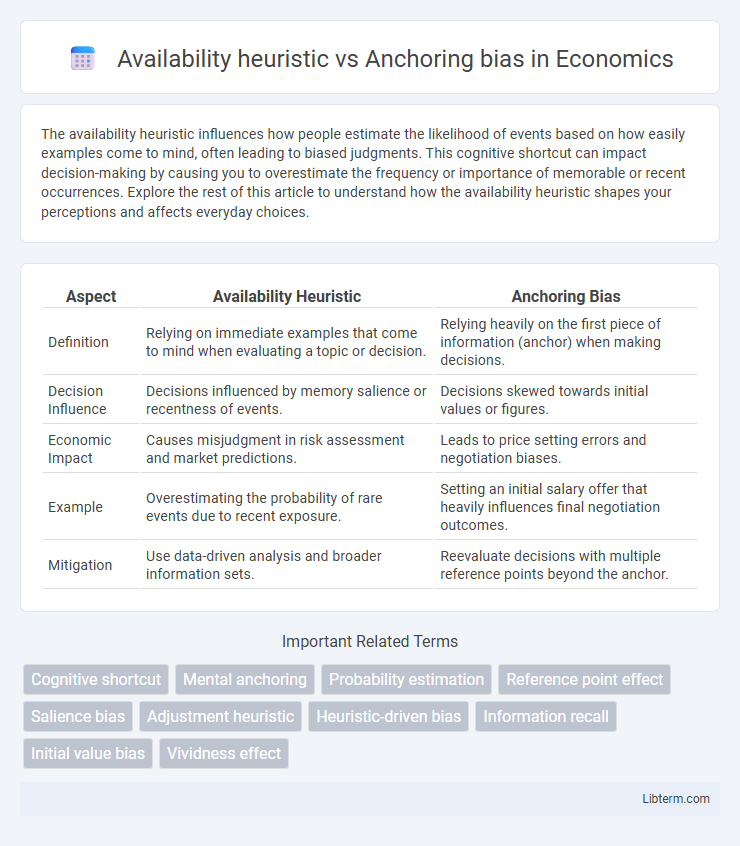The availability heuristic influences how people estimate the likelihood of events based on how easily examples come to mind, often leading to biased judgments. This cognitive shortcut can impact decision-making by causing you to overestimate the frequency or importance of memorable or recent occurrences. Explore the rest of this article to understand how the availability heuristic shapes your perceptions and affects everyday choices.
Table of Comparison
| Aspect | Availability Heuristic | Anchoring Bias |
|---|---|---|
| Definition | Relying on immediate examples that come to mind when evaluating a topic or decision. | Relying heavily on the first piece of information (anchor) when making decisions. |
| Decision Influence | Decisions influenced by memory salience or recentness of events. | Decisions skewed towards initial values or figures. |
| Economic Impact | Causes misjudgment in risk assessment and market predictions. | Leads to price setting errors and negotiation biases. |
| Example | Overestimating the probability of rare events due to recent exposure. | Setting an initial salary offer that heavily influences final negotiation outcomes. |
| Mitigation | Use data-driven analysis and broader information sets. | Reevaluate decisions with multiple reference points beyond the anchor. |
Introduction to Cognitive Biases
Cognitive biases are systematic patterns of deviation from norm or rationality in judgment, influencing decision-making processes. The availability heuristic causes individuals to estimate the likelihood of events based on how easily examples come to mind, often leading to overestimations of recent or vivid occurrences. Anchoring bias involves relying heavily on the first piece of information encountered, skewing subsequent judgments and decisions by insufficiently adjusting from that initial reference point.
Defining the Availability Heuristic
The availability heuristic is a cognitive bias where individuals assess the likelihood of events based on how easily examples come to mind, often influenced by recent exposure or vivid memories. This mental shortcut can lead to overestimating the frequency or importance of dramatic or memorable events. Anchoring bias, in contrast, involves relying heavily on an initial piece of information when making decisions, which can skew judgment even when new data is available.
Understanding Anchoring Bias
Anchoring bias occurs when individuals rely heavily on the initial piece of information (the "anchor") when making decisions, often causing skewed judgments despite subsequent data. This cognitive bias influences numerical estimates, negotiations, and pricing decisions by fixating attention on the anchor value. Effective strategies to mitigate anchoring bias include consciously adjusting away from anchors and seeking diverse information to achieve more accurate conclusions.
Key Differences Between Availability Heuristic and Anchoring Bias
The availability heuristic relies on immediate examples that come to mind when evaluating a decision, causing people to overestimate the importance of recent or memorable events. Anchoring bias involves fixating on an initial piece of information, or "anchor," which heavily influences subsequent judgments and estimates. While availability heuristic is influenced by memory recall ease, anchoring bias is driven by reliance on an initial reference point regardless of its relevance.
How the Availability Heuristic Influences Decision-Making
The availability heuristic influences decision-making by causing individuals to rely on immediately recallable information, often overestimating the likelihood of events that are more memorable or recent. This cognitive shortcut can lead to biased judgments because easily remembered examples, such as vivid news stories, disproportionately affect risk assessment and problem-solving. Unlike anchoring bias, which depends on initial numerical values as reference points, the availability heuristic centers on the mental accessibility of information shaping perception and choices.
The Impact of Anchoring Bias on Judgments
Anchoring bias significantly impacts judgments by causing individuals to rely heavily on the first piece of information encountered, often skewing decision-making processes. This cognitive distortion leads to insufficient adjustments from the initial anchor, resulting in biased assessments and suboptimal outcomes. Understanding anchoring bias is crucial in fields such as finance, marketing, and negotiations, where initial figures or offers can unduly influence final judgments.
Real-World Examples of the Availability Heuristic
The availability heuristic influences decision-making by causing people to rely on immediate examples that come to mind, such as overestimating the frequency of airplane crashes after media coverage of a recent accident. In contrast, anchoring bias occurs when individuals depend too heavily on an initial piece of information, like a first price offered during negotiations, skewing their judgment. Real-world examples of the availability heuristic include heightened fear of shark attacks following viral news stories and increased concern about crime rates after hearing about local incidents.
Common Situations Involving Anchoring Bias
Anchoring bias commonly occurs during negotiations, where the initial price or number set influences all subsequent judgments and decisions, often leading to skewed outcomes. In financial markets, investors fixate on an initial stock price or forecast, impacting their trading behavior despite new information. Real estate buyers frequently anchor on the listing price, affecting their perception of a property's value regardless of market conditions.
Strategies to Reduce Cognitive Biases
Implementing strategies such as seeking diverse perspectives and actively questioning initial impressions can effectively reduce the impact of availability heuristic and anchoring bias. Utilizing decision-making frameworks that emphasize evidence-based analysis helps counteract reliance on readily accessible information or initial reference points. Training programs focused on cognitive bias awareness improve critical thinking skills and promote more objective evaluations in complex decision scenarios.
Conclusion: Navigating Availability Heuristic and Anchoring Bias
Effectively navigating the availability heuristic and anchoring bias requires recognizing how mental shortcuts influence decision-making processes. Employing strategies such as seeking diverse data sources and deliberately adjusting initial reference points can reduce cognitive distortions. Understanding these biases enhances judgment accuracy and supports more rational, evidence-based conclusions in complex scenarios.
Availability heuristic Infographic

 libterm.com
libterm.com